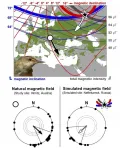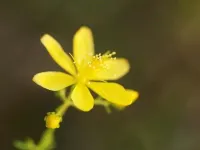INFORMATION:
Scientists manipulate magnets at the atomic scale
2021-02-12
(Press-News.org) Fast and energy-efficient future data processing technologies are on the horizon after an international team of scientists successfully manipulated magnets at the atomic level.
Physicist Dr Rostislav Mikhaylovskiy from Lancaster University said: "With stalling efficiency trends of current technology, new scientific approaches are especially valuable. Our discovery of the atomically-driven ultrafast control of magnetism opens broad avenues for fast and energy-efficient future data processing technologies essential to keep up with our data hunger."
Magnetic materials are heavily used in modern life with applications ranging from fridge magnets to Google and Amazon's data centers used to store digital information.
These materials host trillions of mutually aligned elementary magnetic moments or "spins", whose alignment is largely governed by the arrangement of the atoms in the crystal lattice.
The spin can be seen as an elementary "needle of a compass", typically depicted as an arrow showing the direction from North to South poles. In magnets all spins are aligned along the same direction by the force called exchange interaction. The exchange interaction is one of the strongest quantum effects which is responsible for the very existence of magnetic materials.
The ever-growing demand for efficient magnetic data processing calls for novel means to manipulate the magnetic state and manipulating the exchange interaction would be the most efficient and ultimately fastest way to control magnetism.
To achieve this result, the researchers used the fastest and the strongest stimulus available: ultrashort laser pulse excitation. They used light to optically stimulate specific atomic vibrations of the magnet's crystal lattice which extensively disturbed and distorted the structure of the material.
The results of this study are published in the prestigious journal Nature Materials by the international team from Lancaster, Delft, Nijmegen, Liege and Kiev.
PhD student Jorrit Hortensius from the Technical University of Delft said: "We optically shake the lattice of a magnet that is made up of alternating up and down small magnetic moments and therefore does not have a net magnetization, unlike the familiar fridge magnets."
After shaking the crystal for a very short period of time, the researchers measured how the magnetic properties evolve directly in time. Following the shaking, the magnetic system of the antiferromagnet changes, such that a net magnetization appears: for a fraction of time the material becomes similar to the everyday fridge magnets.
This all occurs within an unprecedentedly short time of less than a few picoseconds (millionth of a millionth of a second). This time is not only orders of magnitude shorter than the recording time in modern computer hard drives, but also exactly matches the fundamental limit for the magnetization switching.
Dr Rostislav Mikhaylovskiy from Lancaster University explains: "It has long been thought that the control of magnetism by atomic vibrations is restricted to acoustic excitations (sound waves) and cannot be faster than nanoseconds. We have reduced the magnetic switching time by 1000 times that is a major milestone in itself."
Dr Dmytro Afanasiev from the Technical University of Delft adds: "We believe that our findings will stimulate further research into exploring and understanding the exact mechanisms governing the ultrafast lattice control of the magnetic state."
ELSE PRESS RELEASES FROM THIS DATE:
Birds can 'read' the Earth's magnetic signature well enough to get back on course
2021-02-12
Birdwatchers get very excited when a 'rare' migratory bird makes landfall having been blown off-course and flown beyond its normal range. But these are rare for a reason; most birds that have made the journey before are able to correct for large displacements and find their final destination.
Now, new research by an international team shows for the first time, how birds displaced in this way are able to navigate back to their migratory route and gives us an insight into how they accomplish this feat.
Writing in Current Biology, the team from Bangor and Keele Universities describe how reed warblers can navigate from a 'magnetic position' beyond what they have ...
Effect of high-dose zinc, ascorbic acid supplementation vs usual care on symptom length, reduction among ambulatory patients with SARS-CoV-2 infection
2021-02-12
What The Study Did: These findings suggest that treatment with zinc, ascorbic acid or both doesn't affect SARS-CoV-2 symptoms.
Authors: Milind Y. Desai, M.D., M.B.A., of the Cleveland Clinic in Ohio, is the corresponding author.
To access the embargoed study: Visit our For The Media website at this link https://media.jamanetwork.com/
(doi:10.1001/jamanetworkopen.2021.0369)
Editor's Note: The article includes conflict of interest disclosures. Please see the article for additional information, including other authors, author contributions and affiliations, conflict of interest and financial disclosures, and funding and support.
INFORMATION:
Media advisory: The full study is linked to ...
Pediatric hospital admissions in 2020 compared with decade before COVID-19
2021-02-12
What The Study Did: Pediatric admissions to U.S. hospitals decreased last year across an array of pediatric conditions and some may represent unmet needs in pediatric care during the COVID-19 pandemic.
Authors: Christopher M. Horvat, M.D., M.H.A., of UPMC Children's Hospital of Pittsburgh, is the corresponding author.
To access the embargoed study: Visit our For The Media website at this link https://media.jamanetwork.com/
(doi:10.1001/jamanetworkopen.2020.37227)
Editor's Note: The article includes conflict of interest and funding/support disclosures. Please see the article for additional information, including other authors, author contributions and affiliations, conflict of interest and financial disclosures, and funding and support.
INFORMATION:
Media advisory: ...
Variations in sensitivity of serological tests among individuals infected with SARS-CoV-2
2021-02-12
What The Study Did: This observational study investigated the sensitivity of antibody tests to detect previous SARS-CoV-2 infection using existing clinical data across the University of California Health system.
Authors: Atul J. Butte, M.D. Ph.D., of the University of California, San Francisco, is the corresponding author.
To access the embargoed study: Visit our For The Media website at this link https://media.jamanetwork.com/
(doi:10.1001/jamanetworkopen.2021.0337)
Editor's Note: The article includes conflict of interest and funding/support disclosures. Please ...
Green tea compound aids tumor-suppressing, DNA-repairing protein
2021-02-12
TROY, N.Y. -- An antioxidant found in green tea may increase levels of p53, a natural anti-cancer protein, known as the "guardian of the genome" for its ability to repair DNA damage or destroy cancerous cells. Published today in END ...
Assessing brain capillaries in COVID-19
2021-02-12
What The Study Did: This case series analyzes brains from autopsies of patients who died of COVID-19 as confirmed by nucleic acid test and with severe pulmonary pathology.
Authors: David W. Nauen, M.D., Ph.D., of Johns Hopkins University in Baltimore, is the corresponding author.
To access the embargoed study: Visit our For The Media website at this link https://media.jamanetwork.com/
(doi:10.1001/jamaneurol.2020.0225)
Editor's Note: The article includes conflicts of interest disclosures. Please see the article for additional information, including other authors, author contributions and affiliations, ...
Study explores neurocognitive basis of bias against people who look different
2021-02-12
PHILADELPHIA--The "scarred villain" is one of the oldest tropes in film and literature, from Scar in "The Lion King" to Star Wars' Darth Vader and the Joker in "The Dark Knight." The trope is likely rooted in a long-evolved human bias against facial anomalies -- atypical features such as growths, swelling, facial paralysis, and scars. A new brain-and-behavior study from researchers in the Perelman School of Medicine at the University of Pennsylvania illuminates this bias on multiple levels.
The researchers, whose findings were published this week in the Annals of the New York Academy of Sciences, used surveys, social simulations, and functional MRI (fMRI) studies to study hundreds of participants' responses and attitudes towards ...
Flowers of St. John's Wort serve as green catalyst
2021-02-12
Since ancient times, St. John's Wort has been used as a medicinal herb covering a wide range of applications such as the treatment of burns, skin injuries, neuralgia, fibrosis, sciatica and depression. Due to its high medicinal potential, the plant known in technical terminology as Hypericum perforatum even became "Medicinal Plant of the Year" in 2015. Now, scientists at TU Dresden have shown that there is much more to the herb than its healing properties.
To this end, two interdisciplinary groups from biology and inorganic chemistry have joined forces and thus achieved astonishing results.
Originally, the research groups led by botanist Prof. Stefan Wanke ...
Here comes the new generation of climate models: the future of rainfall in the Alps
2021-02-12
Less intense mean daily precipitation, more intense and localised extreme events. This is what the future climate scenarios indicate for the Eastern Alps, according to the study "Evaluation and Expected Changes of Summer Precipitation at Convection Permitting Scale with COSMO-CLM over Alpine Space", published by the CMCC Foundation in the journal Atmosphere. The research is conducted in the context of the European project H2020 EUCP (European Climate Prediction system) and contributes to the work of the international scientific community for the development of climate models that can support ...
Biodiversity protects bee communities from disease
2021-02-12
Photos
A new analysis of thousands of native and nonnative Michigan bees shows that the most diverse bee communities have the lowest levels of three common viral pathogens.
University of Michigan researchers netted and trapped more than 4,000 bees from 60 species. The bees were collected at winter squash farms across Michigan, where both managed honeybee colonies and wild native bees pollinate the squash flowers.
All but one species--Apis mellifera, the common European honeybee--are native bees. The number of bee species found at each farm ranged from seven to 49.
Consistently, lower virus levels were strongly linked to greater species richness among the local bee communities. ...



